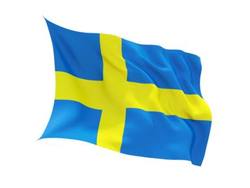
The flag of Finland (Finnish: Suomen lippu, Swedish: Finlands flagga), also called siniristilippu ("Blue Cross Flag"), dates from the beginning of the 20th century. On a white background, it features a blue Nordic cross, which represents Christianity.
The state flag has a coat of arms in the centre, but is otherwise identical to the civil flag. The swallow-tailed state flag is used by the military. The presidential standard is identical to the swallow-tailed state flag but also has in its upper left corner the Cross of Liberty after the Order of the Cross of Liberty, which has the President of Finland as its Grand Master. Like Sweden's, Finland's national flag is based on the Scandinavian cross. It was adopted after independence from Russia, when many patriotic Finns wanted a special flag for their country, but its design dates back to the 19th century. The blue colouring is said to represent the country's thousands of lakes and the sky, with white for the snow that covers the land in winter. This colour combination has also been used over the centuries in various Finnish provincial, military, and town flags.
The first known "Flag of Finland" was presented in 1848, along with the national anthem Maamme. Its motif was the coat of arms of Finland, surrounded by laurel leaves, on a white flag.
The current blue-crossed design was first used in Finland by Nyländska Jaktklubben, a yacht club founded in Helsinki in 1861. In addition to the blue cross on the white background, the yacht club flag had the crowned arms of the province of Uusimaa within two crossed branches in the upper hoist quarter. Except for the position of the cross, the flag was similar to the flag of the St. Petersburg Yacht Club, founded the previous year. The design can be traced to the Russian Navy ensign, which has a blue cross saltire on a white background. During the Crimean War, Finnish merchant ships captured by the British-French fleet flew a flag called Flag of St. George, which was based on the Russian Customs flag. In this variant, the cross was thinner than in the modern flag, and the proportions were equal. Another blue-cross flag was made official in 1861 for private vessels.
In 1910, in connection with Russification of Finland, the Russian authorities decreed that a Russian flag was to be added to the canton. However, this was met with resistance; the flag was derided as the "slave's flag" (orjalippu), and most Finns refused to fly it. Instead, a triangular pennant without this modification was flown, thereby circumventing the decree concerning flags.
Shortly after Finland gained independence in 1917, a competition was held for the design of the Finnish flag. Several different designs were submitted. Regarding the colours, the entries fell mainly into two categories – one using the red and yellow from the Finnish coat of arms, and the other using the present blue and white colours.
One entry had the Dannebrog cross design, but with a yellow cross on a red background. Another entry had diagonal blue and white stripes, but it was criticized[by whom?] as being more suitable for a barber shop than a newly independent country. Akseli Gallen-Kallela proposed a similar cross flag, but with colors inverted (white cross on blue), but this was considered too similar to the Swedish flag and particularly the Greek flag of the time. Finally, artists Eero Snellman and Bruno Tuukkanen specified the final form of the flag. According to tradition, the flag was based on a design by the poet Zachris Topelius in about 1860.
The Finnish state flag was further modified in 1922, when the coronet was removed, and again in 1978 when the shield-shaped coat of arms was changed into a rectangular shape.
QTY
PURCHASE
© 2026 Custom.co.nz - Custom Electronics Ltd | Website by eDIY